Catalogue > List by artist
Browse the entire list of Rencontre Internationales artists since 2004. Use the alphabetical filter to refine your search. update in progress
Thom Andersen
Catalogue : 2016The Thoughts That Once We Had | Experimental doc. | hdv | color and b&w | 108:0 | USA | 2015
Thom Andersen
The Thoughts That Once We Had
Experimental doc. | hdv | color and b&w | 108:0 | USA | 2015
Film history can be written in many ways. One of the more speculative takes is due to the French philosopher Gilles Deleuze, and it is his famous two-volume `Cinéma I-II` that the American essayist Thom Andersen has adapted as a collage of extracts from hundreds of films. And even though there are both cult hits and canonised classics among them, we are light years from a traditional introduction to the bumpy history of cinema. Who would have thought, for example, that you could create a colour theory about black-and-white films? Deleuze draws new and unexpected connections across the film medium`s one hundred year history, and the poetically named `The Thoughts That Once We Had` draws lines between the dots that the French thinker had at the time. Just like Andersen`s magnum opus `Los Angeles Plays Itself`, his new essay is a cinematic whirlwind that blows through the history of the moving image without showing consideration for chronology. A film for everyone who is bitten by the cinephile bug – and for those who share a healthy enthusiasm for the infinite potential of both the film medium and the mind.
Thom Andersen (born 1943, Chicago) is a filmmaker, film critic and teacher. He attended Berkeley in the early 1960s and then returned to his hometown of Los Angeles to attend USC School of Cinematic Arts, where he studied with Arthur Knight and eventually assisted on Knight`s project The History of Sex in Cinema. While at USC Andersen met long-time friend and collaborator Morgan Fisher, who assisted on Andersen`s student film Melting, a portrait of a sundae. He regularly attended local screening series including shows by the Trak Film Group and Movies `Round Midnight and famously wrote about an unpopular screening of Andy Warhol`s Sleep. After USC, Andersen attended UCLA and completed his experimental documentaries Olivia`s Place and Eadweard Muybridge, Zoopraxographer. During the 1970s, his films screened at Los Angeles` Theatre Vanguard and Berkeley`s Pacific Film Archive. He was the programmer for LA Filmforum in Los Angeles during the late 90`s. Andersen`s film Los Angeles Plays Itself won the National Film Board Award for Best Documentary at the 2003 Vancouver International Film Festival, was voted best documentary of 2004 by the Village Voice Critic`s Poll, and was voted one of the Top Ten Films of the Decade by critics at Cinema Scope. In 2010 he completed Get Out of the Car, a portrait of signs and abandoned spaces set to Los Angeles music. In spring 2012, Andersen took part in the three month exposition of Whitney Biennial. He has taught at the SUNY Buffalo and Ohio State University. He currently teaches film theory and history at the California Institute of the Arts.
Thom Andersen
Catalogue : 2011Get Out of the Car | Experimental doc. | 16mm | color | 34:0 | USA | 2010

Thom Andersen
Get Out of the Car
Experimental doc. | 16mm | color | 34:0 | USA | 2010
From the director of "Los Angeles Plays Itself" comes another city symphony exploring Los Angeles' gentrification through a thoughtful montage of façades and a playful excursus through its musical history.
Alice Anderson
Catalogue : 2007Souffler n'est pas jouer | Experimental fiction | betaSP | color | 14:30 | France | 2005
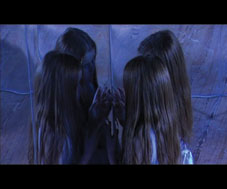
Alice Anderson
Souffler n'est pas jouer
Experimental fiction | betaSP | color | 14:30 | France | 2005
In a gymnasium, a seventeen year old girl is training on a trampoline. Her father, who is coaching her, is barking out instructions. The forced training causes her to suffer but she is obsessed with the idea of winning the big double somersault competition. With the prize money her father will finally be able to pay their debts. Natasha cannot disappoint him. She has the feeling that he doesn't love her as much now that she has grown up. The gold medal will change everything. The accident is inevitable, she misses her landing and hurts her head. Lacking money, his father decides to look after her himself: the mother recommands total isolation in one particular room of the house. For several weeks, the father has been observing Natasha through the key hole of the room with mirrors. She talks alone, he thinks. And she doesn't look like she wants to get better. The great somersault competition seems compromised. Then, one day, the door opens and Natasha receives a gift from her father: a role-play. The mother gets dangeroulsly close to her. Now she is ready. She convinces her father to contact the judges of the federation so that they accept her late inscription to the competition. She is determined to show them what she is capable of, her father is going to love her again, unless her mother intervenes...
Alice Anderson was born in London in 1976 and was raised in the south of France. She studied at the Beaux-Arts of Paris (1998-2001), received the Gilles Dusein prize for her videos (2002), then left for London to complete a M.A. at Goldsmiths College in London (2002-04), where she has been living since. She has shown her work in such prestigious places as: The European House of Photography, The Pompidou Centre, Emap Museum in Korea, The Anna Norlender Museum in Sweden, The Man Museum in Italy, Bloomberg Space in London, and Art Unlimited in Basel. Most recently she presented a new tale at the Yvon Lambert Gallery at her personal exhibition in January 2007.
J Tobias Anderson
Catalogue : 2018Where Did It All Start? | Animation | hdv | color | 1:10 | Sweden | 2017
J Tobias Anderson
Where Did It All Start?
Animation | hdv | color | 1:10 | Sweden | 2017
The simplest of questions. An overwhelming silence. The conundrum of existence.
Born in 1971. Grew up on Gotland in the Baltic Sea. Education includes the University Collage of Arts Crafts & Design as well as the Royal Collage of Art, both in Stockholm. Lives in Nacka just outside of Stockholm. Working mainly with video and animation and moving between narrative and non-narrative works. Has created around 40 films. Also experimenting with different forms of music and sound installations. Notable exhibitions include P.S.1 Contemporary Art Center in New York, Kunst-Werke Berlin, CaixaForum in Barcelona and Museo de Colecciones ICO in Madrid, as well as solo exhibitions at MMC Luka in Pula Croatia, ak28 in Stockholm and Uppsala Art Museum in Sweden.
Catalogue : 2017A Work of Art | Animation | hdv | black and white | 1:36 | Sweden | 2016
J Tobias Anderson
A Work of Art
Animation | hdv | black and white | 1:36 | Sweden | 2016
A reflection on the artist’s own work, mirrored in a dialogue involving three secondhand characters. Together they make an honest evaluation of the artwork to reveal the harsh truth.
Born in 1971. Grew up on Gotland in the Baltic Sea. Education includes the University Collage of Arts Crafts & Design as well as the Royal Collage of Art, both in Stockholm. Lives in Nacka just outside of Stockholm. Working mainly with video and animation and moving between narrative and non-narrative works. Has created around 40 films. Also experimenting with different forms of music and sound installations. Notable exhibitions include P.S.1 Contemporary Art Center in New York, Kunst-Werke Berlin, CaixaForum in Barcelona and Museo de Colecciones ICO in Madrid, as well as solo exhibitions at MMC Luka in Pula Croatia, ak28 in Stockholm and Uppsala Art Museum in Sweden.
Catalogue : 2016Allt blir självklart, genomlyst | Animation | hdv | color | 2:30 | Sweden | 2015
J Tobias Anderson
Allt blir självklart, genomlyst
Animation | hdv | color | 2:30 | Sweden | 2015
In a colorful setting, where thoughts and ideas aren’t necessarily black or white, a situation of non-communication is enacted. Two men and a woman are throwing their most inner thoughts at each other, but finding little solace in the others’ words. Communication can sometimes be unidirectional, even though a dialogue is taking place, and where certainty can be a comfort, perhaps skepticism and doubt should be the default.
Born in 1971. Grew up on Gotland in the Baltic Sea. Education includes the University Collage of Arts Crafts & Design as well as the Royal Collage of Art, both in Stockholm. Lives in Nacka just outside of Stockholm. Working mainly with video and animation and moving between narrative and non-narrative works. Has created around 40 films. Also experimenting with different forms of music and sound installations. Notable exhibitions include P.S.1 Contemporary Art Center in New York, Kunst-Werke Berlin, CaixaForum in Barcelona and Museo de Colecciones ICO in Madrid, as well as solo exhibitions at MMC Luka in Pula Croatia, ak28 in Stockholm and Uppsala Art Museum in Sweden.
Catalogue : 2013A Sensation! | Animation | dv | color | 1:38 | Sweden | 2012
J Tobias Anderson
A Sensation!
Animation | dv | color | 1:38 | Sweden | 2012
Material is what counts!
Born in 1971. Grew up on Gotland in the Baltic Sea. Education includes the University Collage of Arts Crafts & Design as well as the Royal Collage of Art, both in Stockholm. Lives in Nacka just outside of Stockholm. Working mainly with video and animation and moving between narrative and non-narrative works. Has created around 40 films. Also experimenting with different forms of music and sound installations. Notable exhibitions include P.S.1 Contemporary Art Center in New York, Kunst-Werke Berlin, CaixaForum in Barcelona and Museo de Colecciones ICO in Madrid, as well as solo exhibitions at MMC Luka in Pula Croatia, ak28 in Stockholm and Uppsala Art Museum in Sweden.
Catalogue : 2012A Hand That Speaks | Video | hdv | color | 1:9 | Sweden | 2011
J Tobias Anderson
A Hand That Speaks
Video | hdv | color | 1:9 | Sweden | 2011
"Take a look at these hands. Take a look at these hands. The hand speaks."
J Tobias Anderson was born in 1971 and grew up on Gotland in the Baltic Sea. His education includes the University Collage of Arts Crafts & Design as well as the Royal Collage of Art, both in Stockholm. He lives in Nacka just outside of Stockholm. Working mainly with video and animation Anderson has moved between narrative and non-narrative works and through the years he has created almost 40 films. He has also been experimenting with different forms of music and sound installations. Notable exhibitions include P.S.1 Contemporary Art Center in New York, Kunst-Werke Berlin, CaixaForum in Barcelona and Museo de Colecciones ICO in Madrid, as well as solo exhibitions at MMC Luka in Pula Croatia, ak28 in Stockholm and Uppsala Art Museum in Uppsala, Sweden. He is collaborating with Filmform Foundation in Stockholm, Espaivisor in Valencia, Spain and Factory-Art in Berlin.
Catalogue : 2011A Veracity A Mendacity | Art vidéo | | color | 4:58 | Sweden | 2010
J Tobias Anderson
A Veracity A Mendacity
Art vidéo | | color | 4:58 | Sweden | 2010
A man in confrontation with two women, one vulnerable and easily influenced, the other hesitant and questioning. On one hand the man is preching a veracity to the already converted and on the other a mendacity to the doubtful. Or is it the other way around? "A Veracity A Mendacity" questions if there, in the name of reason, can exist only one truth to any situation, and who should have the mandate to tell others what is right and what is wrong.
J Tobias Anderson was born in 1971 and grew up on Gotland in the Baltic Sea. His education includes the University Collage of Arts Crafts & Design as well as the Royal Collage of Art, both in Stockholm. He lives in Nacka just outside of Stockholm. Working mainly with video and animation Anderson has moved between narrative and non-narrative works and through the years he has created almost 40 films. He has also been experimenting with different forms of music and sound installations. Notable exhibitions include P.S.1 Contemporary Art Center in New York, Kunst-Werke Berlin, CaixaForum in Barcelona and Museo de Colecciones ICO in Madrid, as well as solo exhibitions at MMC Luka in Pula Croatia, ak28 in Stockholm and Uppsala Art Museum in Uppsala, Sweden. He is collaborating with Filmform Foundation in Stockholm and Espaivisor in Valencia, Spain.
Catalogue : 2010The Wind | Animation | dv | black and white | 3:44 | Sweden | 2009
J Tobias Anderson
The Wind
Animation | dv | black and white | 3:44 | Sweden | 2009
These words are all true. These words are all used. This is the way the wind is blowing. This is the wind of the reality in which we live. All words are already spoken. All things are already said. Nothing is original. Nothing is new.
J Tobias Anderson was born in 1971 and grew up on Gotland in the Baltic Sea. His education includes the University Collage of Arts Crafts & Design as well as the Royal Collage of Art, both in Stockholm. He lives in Nacka just outside of Stockholm. Working mainly with video and animation Anderson has moved between narrative and non-narrative works and through the years he has created almost 40 films. He has also been experimenting with different forms of music and sound installations. Notable exhibitions include P.S.1 Contemporary Art Center in New York, Kunst-Werke Berlin, CaixaForum in Barcelona and Museo de Colecciones ICO in Madrid, as well as solo exhibitions at MMC Luka in Pula Croatia, ak28 in Stockholm and Uppsala Art Museum in Uppsala, Sweden. He is collaborating with Filmform Foundation in Stockholm and Espaivisor in Valencia, Spain.
Catalogue : 2009Delusion Disillusion | Art vidéo | dv | black and white | 3:33 | Sweden | 2008
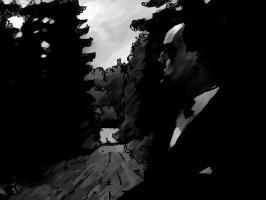
J Tobias Anderson
Delusion Disillusion
Art vidéo | dv | black and white | 3:33 | Sweden | 2008
A dark forest, a neverending road, two men with differing ideas on how to approach a problem. The outline of Delusion Disillusion is quite simple, but the possibilities of interpretation are more complex. Are the men referring to a matter of more personal character, or are they speaking of something much more general? The contrast between the density of the trees in the beginning of the video and the final, almost clear-cut forest, gives us one hint towards a possible solution.
Born 1971 in Gothenburg, Sweden. Living and working in Stockholm, Sweden Artistic education: 1993-98 University Collage of Arts, Crafts and Design, Art Department, Stockholm 1998-99 Royal Collage of Art, Video Department, Stockholm Videoartist focusing mainly on animation and appropriation art. Experimenting with a number of different techniques, such as video, painting, illustration, sound and music, with the main work still being made for video - around 30 videoworks have been created between 1997 and 2006. Explorations with the starting point in material that somehow can be considered generally well known are usually the bases for the creation of the works. Often the videos are based on cinematographic issues, and deal with visual or audiovisual explorations. Has been screened at numerous occasions, in exhibitions and festivals worldwide. Represented with videoworks at several art institutions, among them Moderna Museet in Stockholm and IVAM, Institut Valencià d`Art Modern.
Catalogue : 2007A Small Part of the World | Animation | dv | color | 2:53 | Sweden | 2006
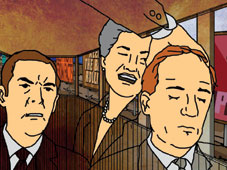
J Tobias Anderson
A Small Part of the World
Animation | dv | color | 2:53 | Sweden | 2006
"A Small Part of the World" is a video full of statements and slogans. Which should we believe in, and which should we not? In an overpopulated world, how shall we find the true way to live our lives in harmony? Don't treat the sayings of religious or political leaders as truths and let them steer you off your way to what's right in life. The Chinese Communist Party's slogan: "Seek truth from facts" might be a statement to follow, but which are the "right" truths - which is the way you choose in life?
Born 1971 in Gothenburg, Sweden, J. Tobias Anderson lives and works in Stockholm, Sweden. From 1993-98 he studied Crafts and Design at the University College of Arts, in Stockholm. From 1998-99 he was a student in the Video Department at the Royal College of Art, Stockholm. He is a video artist who focuses mainly on animation and appropriation art. He experiments with a number of different techniques, such as video, painting, illustration, sound, and music, with the main work still being made for video - around 30 video works have been created between 1997 and 2006. His explorations with the starting point in material that somehow can be considered generally well known are usually the bases for the creation of his works; often the videos are based on cinematographic issues, and deal with visual or audiovisual explorations. His works have been screened on numerous occasions in exhibitions and festivals worldwide. His with video work is represented at several art institutions, among them Moderna Museet in Stockholm.
Catalogue : 2006Whereto I Go | Art vidéo | dv | black and white | 4:46 | Sweden | 2005
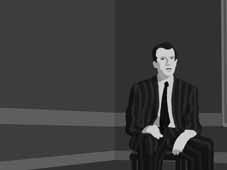
J Tobias Anderson
Whereto I Go
Art vidéo | dv | black and white | 4:46 | Sweden | 2005
A video that displays a man's confrontation with his own self. A meeting that is not always as rewarding as one might have hoped. Classic filmsequences have been re-cut and animated to illustrate this dilemma, and the final imagery is created in a highly contrasted style, with characters echoing of decades from long ago.
J Tobias Anderson was born in 1971 in Gothenburg, Sweden. He lives and works in Stockholm, Sweden. Originally a painter, and since 1993 working with videoart and animation, he now experiments with a number of different techniques, such as video, painting, illustration, sound and music, with the main work still being made for video. He has been screened at numerous occasions, festivals and exhibitions worldwide. He is represented with videoworks for instance at the Modern Museum of Art in Stockholm.
Stephen Andrews
Catalogue : 2007The Quick and The Dead | Animation | dv | color | 1:0 | Canada | 2004
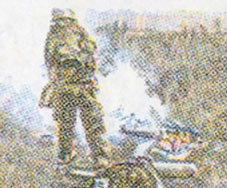
Stephen Andrews
The Quick and The Dead
Animation | dv | color | 1:0 | Canada | 2004
An animation based on a video clip from the Iraq war.
Stephen Andrews has exhibited his work in Canada, the U.S., Brazil, Scotland, France, and Japan. His work deals with memory, identity, surveillance and their representations in various media.
Stephen Andrews
Catalogue : 2014Dramatis Personae | | | | 6:10 | Canada | 0
Stephen Andrews
Dramatis Personae
| | | 6:10 | Canada | 0
Stephen Andrews, John Greyson
Catalogue : 2008On message | Experimental video | dv | color | 9:30 | Canada | 2006
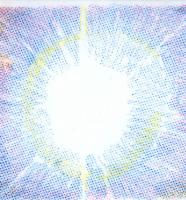
Stephen Andrews, John Greyson
On message
Experimental video | dv | color | 9:30 | Canada | 2006
An analog animation using the same set of drawings to tell four different versions of the same story. The emotional fallout of two witnesses to a police shooting, a musical about groovy gay boys making the scene, a cop show about the chase and arrest of a suspect and a news report about soldiers on leave in Iraq.
Stephen Andrews was born in 1956 in Sarnia, Ontario Canada. He has exhibited his work in Canada, the U.S., Brazil, Scotland, France and Japan. He is represented in the collections of the National Gallery of Canada, as well as many private collections. His work deals with memory, identity, surveillance and their representations in various media. John Greyson is a Toronto film/video artist whose shorts, features and installations include: Fig Trees (2003, Oakville Art Galleries); Proteus (Best Actor, Sithenghi 2003); The Law of Enclosures (2000, Best Actor Genie); Lilies (1996 - Best Film Genie, Best Film at festivals in Montreal, Johannesburg, Los Angeles, San Francisco); Un©ut (1997, Honourable Mention, Berlin Film Festival); Zero Patience (1993 - Best Canadian Film, Sudbury Film Festival); The Making of Monsters (1991 - Best Canadian Short, Toronto Film Festival, Best Short Film Teddy - Berlin Film Festival); and Urinal (1988 - Best Feature Teddy, Berlin Film Festival). He co-edited Queer Looks, a critical anthology on gay/lesbian film & video (Routledge, 1993), is the author of Urinal and Other Stories (Power Plant/Art Metropole, 1993), and has published essays and artists pieces in Alphabet City, Public, FUSE, and twelve critical anthologies. An assistant professor in film production at York University, he was awarded the Toronto Arts Award for Film/Video, 2000, and the Bell Canada Video Art Award in 2007.
Claire Angelini
Catalogue : 2013Jeune, révolution! 2007-2012 | Experimental doc. | hdv | color | 13:12 | France, Germany | 2012
Claire Angelini
Jeune, révolution! 2007-2012
Experimental doc. | hdv | color | 13:12 | France, Germany | 2012
(Brise la mer ! / Jeune, révolution !) : deux courts films prennent le spectateur en étau, et à travers eux, deux paroles sur l?histoire : celle de Narriman B., qui s?interroge sur les raisons de la guerre d?Algérie à l?occasion de la commémoration de l?Indépendance (1962). Et celle d?Ikbel Z., confronté au délitement de la Révolution de jasmin et au désenchantement de la jeunesse tunisienne. Quand aux cuves de pétrole du port de Béjaia, (Algérie), répondent les toupies d?abord fougueuses, puis de plus en plus lentes, d?une table de café tunisienne, de quel tour sur soi-même la révolution, dans l?un et l?autre de ces deux pays, a-t-elle été porteuse ?
Claire Angelini, artiste et cinéaste (ensba Paris / Sorbonne / HFF Munich), interroge le rapport de l?art à l?histoire comme inscription du politique, sous les espèces de la trace, la ruine, la réminiscence et de la survivance des images. Le cinéma comme outil critique sensible et comme dispositif visuel et sonore, lui permet de questionner l?histoire qui hante notre espace commun aujourd?hui et ce faisant, d?en interroger la représentation. Diffusions récentes : MAC-Santiago du Chili 2012 / galerie Fucares Madrid 2012 / Instants video Marseille 2012 / Underdox 07 Munich 2012 / Cinemateca brasileira Sao Paolo 2012 / Etats généraux du film documentaire Lussas 2011 / Cinéma du Réel Paris 2011 / Institut franco-japonais Tokyo 2010 / Viennale 2009
Catalogue : 2011MARCHE / ARAGON | Experimental doc. | dv | color | 23:7 | France, Germany | 2010
Claire Angelini
MARCHE / ARAGON
Experimental doc. | dv | color | 23:7 | France, Germany | 2010
Marche / Aragon montre comment la guerre a traversé et influencé deux villages du sud de l?Europe, l?un en Italie méridionale, dans les Marches, l?autre en Espagne, dans la province de Huesca. Ortezzano a vécu la montée du fascisme dans les années 30. Belver au contraire, a tenté une expérience unique et singulière d?anarchisme au moment de la République espagnole. Formellement tout oppose les Marches à l?Aragon : d?un côté se développe un film sans paroles au fil d?un album communal, seul dépositaire d?une mémoire inavouable. De l?autre, un récit se déploie, au fil d?un témoignage incarné par la voix d?un survivant de la guerre d?Espagne. La musique aussi, devient, au cours du film un protagoniste essentiel de Marche /Aragon, chargée qu?elle est de sa propre mémoire politique.
Diplômée de l?Ecole Nationale Supérieure des Beaux-Arts de Paris, où elle a étudié la photographie et le montage sonore, Claire Angelini, titulaire d?une maîtrise d?Histoire de l?art, a fréquenté la section documentaire de l?HFF (Hochschule für Film und Fersehen) de Munich. Sa production inclut l?installation, le film, la vidéo, la photographie, le son et le dessin. Claire Angelini vit et travaille à Munich et à Paris. Ses films les plus récents, ont été présentés à l?Institut franco-japonais de Tokyo, à la Bobine de Grenoble, à la Viennale 2009, à la Maison des Arts d?Amiens, à la 12e BIM de Genève, aux Instants vidéo à Marseille, au festival Underdox de Munich, à la Kunsthalle de Vienne, au Festival internacional de videoarte de Gijon, à la Nuit Blanche 2008, ainsi que dans différents cinémas en France et en Allemagne, et, dans le cadre des Rencontres Internationales Paris-Berlin-Madrid, au Centre Georges Pompidou, au Musée du Jeu de Paume, à la Haus der Kulturen der Welt, ainsi qu?au Museo Reina Sofia de Madrid.
Catalogue : 2010La mémoire n'est pas un jeu d'enfant | Documentary | dv | color | 52:50 | France, Germany | 2009
Claire Angelini
La mémoire n'est pas un jeu d'enfant
Documentary | dv | color | 52:50 | France, Germany | 2009
1 woman/ 3 countries/ 3 wars / Following a female figure as she is revisiting the places of her childhood, this film summons up, through the devices it employs, the crossed categories of individual memory and history in a space which is itself composed of the accumulated layers of past and present. Set in France, Tunisia and Algeria, the film looks at how we are affected by history in the places where we grow up. A long journey of recollections and words set against the images and sounds of the landscapes. It is an examination of the relationship between subjective memory, territory and the consciousness of the adult.A political film in the deepest sense of the word.
Catalogue : 2008SHE/SEE | Documentary | dv | color | 20:0 | France, Germany | 2007
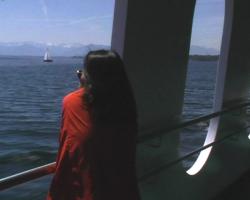
Claire Angelini
SHE/SEE
Documentary | dv | color | 20:0 | France, Germany | 2007
Ce film, fait travailler les éléments d?une improbable rencontre, celle d?une « boat-people » qui a fui son pays, le Vietnam, pour aboutir en Allemagne et du lac de Starnberg nimbé du souvenir mythifié de Sissi et de Louis II de Bavière. Autour du corps présent-absent de la réfugiée ?celui aussi d?un souvenir qui se délite ? se déploie une narration fragmentaire et stratifiée. Quelle image peut saisir en effet la caméra aujourd?hui de cet itinéraire de peur inscrit à même le corps, déplacé dans le tracé paisible d?une excursion touristique « sans histoire » ? Qui parle, et de quoi dans ce jeu complexe des questions-réponses à trois voire quatre voix, et en trois langues (français, allemand, vietnamien) ? De l?impossible palimpseste, émergent des fragments d?histoire : celle de cette femme, celle de son pays déchiré, celle de son voyage en mer, et au-delà celle de la condition de réfugié dans le monde actuel. La disposition des voix, et les incertitudes de la traduction ouvrent sur un vide, délinéant le manque de l?exilée, l?indécision quant à l?identité de celle qui parle, indécision identitaire, devenue sa blessure invisible.
Bio-Filmographie Diplômée de l?Ecole Nationale Supérieure des Beaux-Arts de Paris, où elle a étudié la photographie et le montage sonore, Claire Angelini, qui est titulaire d?une maîtrise d?Histoire de l?art, a aussi fréquenté la section documentaire de l?H.F.F. (Hochschule für Film und Fersehen) de Munich. Circulant entre les langues et les villes européennes, elle s?intéresse plus particulièrement dans son travail aux rapports entre l?art et l?histoire, dans le cadre d?une production multimédia incluant aussi bien l?installation que le film ou la video, la photographie, le son, ou encore le dessin. Claire Angelini vit et travaille actuellement à Munich et à Paris. Films 1996 La minorité, Hi8 transféré sur VHS, 2 minutes 30. (Editions video Artos/ Athènes) 2002 Réciprocités, mini dv, 3 x 60 minutes. (Zweite Architekturwoche, München, Instants video, Martigue, 2004) 2004 Un trou dans le gant, mini dv, 32 minutes. (Kunsthalle Vienne 2006, Université du Québec à Montréal 2006, festival internacional de video arte y fotografia, Gigon, Espagne, 2006, Instants video, Friche de la Belle de Mai, Marseille, 2006.) Ici s?atteint la limite de l?effort pédagogique, mini dv, 22 minutes. (Instants video, Friche de la Belle de Mai, Marseille, 2006.) Lullaby, mini dv, 6 minutes. (Spiegel/ Lothringer 13, München, 2004) 2005 Es geht eine dunkle Wolk herein, mini dv, 20 minutes. (Kunsthalle Vienne 2006, Rencontres internationales Paris-Berlin, Musée du Jeu de Paume, Paris, 2006, Rencontres internationales Paris-Berlin-Madrid, Circulo de Bellas Artes, Madrid, 2007, Rencontres internationales Paris-Berlin, Kino Babylon, Berlin 2007) 2007 Loci soli/Soliloques, mini dv, 21 minutes. (Programmation annuelle des Instants video, marseille 2007- 2008) SHE/SEE, mini dv, 22 minutes. ( Biennale de l?Image, Saint-Gervais, Genève, 2007) En cours : La mémoire n?est pas un jeu d?enfant ( production Atopic/Christophe Gougeon/Aide à l?écriture et au développement, CNC) et Et tu es dehors, installations multimédia (production Finavril/Emmanuel Deswartes).
Catalogue : 2007Es geht eine dunkle Wolk'herein | Experimental doc. | dv | color and b&w | 20:0 | France, Germany | 2005
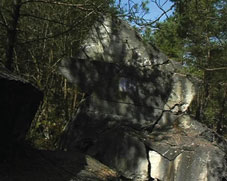
Claire Angelini
Es geht eine dunkle Wolk'herein
Experimental doc. | dv | color and b&w | 20:0 | France, Germany | 2005
During a walk in three different places in Bavaria - first in an idyllic park in the heights of Munich, which is the hill of the Olympic park, then a residential ensemble at the shores of Starnberg Lake in Feldafing, and finally the Mühldorf forest, a village on the Austrian border - heavy with history from Second World War, tangible fragments come back to haunt the images of today under the form of documentary archives. The interpretation of very slow shots that allow for the materialization, the breathing, and the changing light of natural spaces is left up to the public's imagination. The film begins with the idea that our spaces of life and daily landscapes carry indelible traces of history. But here history must be seen as a subset of geology as witness of man's place and destiny in the world.
Claire Angelini was born in Nice, France, and currently lives and works in Munich, Paris, and Geneva. She has a degree in Plastic Arts from the Ecole nationale supérieure des Beaux-Arts de Paris, and in Art History from the Sorbonne, Paris. She obtained various grants and artist residencies since 1998 : Production Aid, OFAG 2006; Development Aid, CNC 2005; Writing Aid, CNC, 2004; FIACRE, 2001; Directing Aid, Cultural Affairs of the City of Munich, 2001, Bourse Akademie Schloss Solitude 1999-2000; Artist Residency Villa Concordia 1998; and Bourse Jeune Création/OFAG 1998. Recent exhibitions include: Nov. 2006, Encuentros Internationales de Videoarte y Fotografia, Gigòn, Spain; Oct. 2006, Instants Video Marseille, Programme Oasis; March 2006, National Institute of Art History, Paris; Feb. 2006, Videotheka, Kunsthalle Vienne; May 2005, Färthensuche, Spiegel/Lothringer 13, Munich; Sept. 2004, "Hier liegt die Grenze des pädagogischen Bemühens", Orstermine 2004, Munich; Aug. 2004, Remix, Spiegel/Lothringer; April 2004, Intervalles, galerie Martine et Thibault de la Châtre, Paris; April 2003, Réciprocités, Goethe-Institut, Rome.
Dominic Angerame
Catalogue : 2006Anaconda target | Experimental video | dv | black and white | 8:0 | USA | 2005
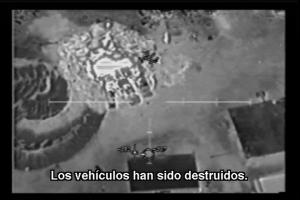
Dominic Angerame
Anaconda target
Experimental video | dv | black and white | 8:0 | USA | 2005
?We don?t have time to get scared, everything happens in a few seconds. ?The sight lights up just in front of the windshield, everything is ready for the computer to do its work. ?It?s the computer that has the last word.??Paul Virilio About 2,000 troops from the US led military coalition were engaged in close in combat on March 4, 2002 with small pockets of suspected al Qaeda and Taliban fighter in the rugged terrain of north-eastern Afghanistan as part of an operation called Operation Acaconda.... The footage contained in this piece was from part of this mission. ?Other than appending a a title card and a quotation by media theorist Paul Virilio at the beginning, Angerame`s latest video work is a complete found-object: military footage of an offensive operation on a mosque in Afghanistan. It`s a cliché for me to point out that for the first few minutes of the running time, I honestly couldn`t tell if I was watching actual military surveillance imaging or a videogame, but the ineluctable appositeness of the cliché seems to be one of Angerame`s major points. After CNN and Baudrillard and, in fact, Virilio, we still have the same problem -- X-Box Warriors of eighteen and nineteen going off to execute our ordnance. Some viewers I spoke with were rankled by Angerame`s bald, untreated presentation of the material, feeling like not enough "art" had been performed. But this viewpoint overlooks context, the resistant act of dropping this horrendous material into the rarefied aesthetic domain of an experimental film screening. (As Americans, our tax dollars spent millions in the production of this lo-tech snuff film.) In the end, nothing else in the Views program jolted me so far out of my contemplative state of mind; sitting and watching the next film, as opposed to leading the entire audience out into the street for some uncivil disobedience, felt vaguely obscene. And yet . . . And yet . . . we know it?s never that simple. Right? ?Michael Sicinski Exhibitions: Toronto International Film Festival, 2004 Onion City Film Festival, Chicago, 2004 New York Film Festival, Lincoln Center, 2004 Viennale, Vienna 2004 Pacific Film Archives, Berkeley, California 2004 Hong Kong International Film Festival, 2005 Director?s Choice, Black Maria Film Festival, 2005 Australian Center for Moving Image, Canberra, Australia, 2005 Rotterdam Film Festival, 2005 Nashville Film Festival, 2005 Tiburon Film Festival, 2005 San Francisco Cinematheque, 2005 Big Muddy Film Festival, 2005, First Place European Media Arts Festival, Osnabruck, Germany, 2005 Black and White Festival, Porto, Portugal Athens International Film Festival, Athens Ohio Fear No Film Festival, Salt Lake City, 2005 Empire Film Festival, 2005 Cracow Film Festival, 2005 DMZ_2005 Exhibition, Korea, 2005 Splitz Film Festival, Croatia, 2005 Torino International Film Festival, 2005 Sarajevo Film Festival, 2005 Montreal International Film Festival, 2005 Seoul Net&Film Festival, 2005 VII Festival Iberoamericano De Cine De Santa Cruz, Bolivia
?To see the city through the eyes of Dominic Angerame is to see an organic beast of concrete that sifts and breathes in rich shades of black and white.?--Silke Tudor, SF Weekly Since 1969, Dominic Angerame has made more than 35 films that have been shown and won awards in film festivals around the world. Two Cine Probe Series at the Museum of Modern Art in New York City have also honoured him -- in 1993 and in June 1998. His most recent work Anaconda Targets (2004) is being exhibited at the Toronto International Film Festival, Onion City Film Festival, Chicago, New York Film Festival, and the Vienalle in Vienna and will screen at the Hong Kong International Film Festival, Rotterdam Film Festival, Nashville Film Festival, and many more. His series of films Battle Stations?A Navel Adventure (2002), Pixiescope (2003), The Waifen Maiden (2003), and Consume (2003). These films are in the process of being screened in festivals around the world, including Turino Film Festival, Madrid, Recontres Paris/Berlin and more information regarding them is available by request. They were also exhibited by the San Francisco Cinematheque at the Yerba Buena Center on December 11, 2003 Angerame teaches filmmaking/cinema studies/criticism the San Francisco Art Institute as a visiting artist. He has also taught film production and cinema studies at the University of California Berkeley, Extension, and New College of California; and has been a guest lecturer and visiting artist for Stanford University, the School of the Art Institute of Chicago, the Graduate School of Theology in Berkeley, and others. Dominic Angerame has been the Executive Director of Canyon Cinema for the past twenty years. Under his leadership Canyon Cinema has become one of the world?s most renowned distributors of avant-garde and experimental films. Canyon Cinema?s contribution to the field of experimental/avant-garde filmmaking is historic and heroic. For his filmmaking projects, Angerame has been awarded film productions grants from The Illinois Arts Council; Samuel B. Mayer Foundation; three grants from the National Endowment for the Arts Western Regional Fellowships, The Film Arts Foundation. In the Spring of 1999 Mr. Angerame curated a series of fourteen film programs for the San Francisco Museum of Modern Art. This extremely successful series was called SHAKE THE NATION and traced the development of avant-garde filmmaking in San Francisco from 1939 to the present. Mr. Angerame has been nominated for a John D. Rockefeller Foundation Grant in Filmmaking for the year 2000. Dominic?s film ?In the Course of Human Events (1997) of a group exhibition held at the Fondation Cartier in Paris from November 2002 through March 2003 entitled ?Ce Qui Arrive? curated by noted urbanist Paul Virilio.
Alex Anikina
Catalogue : 2016Ostrannenie | Experimental film | hdv | color | 8:13 | Russia, United Kingdom | 2015
Alex Anikina
Ostrannenie
Experimental film | hdv | color | 8:13 | Russia, United Kingdom | 2015
Ostrannenie is a video-exploration of a territory and of the language belonging to it. It traces a history of imaginary lands from the times when the Earth rested on elephants’ backs to the current moment of Google Maps and glossy stock footage. The map of the world in the video becomes a field where the history of geographical discoveries is intertwined with the histories of the human imagination, with the camera’s eye and the gaps in language.
Alex Anikina is an artist-researcher who currently lives and works in London, working primarily with texts, language-based works, experimental films and objects. Her artistic and academic practices both revolve around the exploration of human relationship with technology and knowledge through experimental film. Her works are held in the collection of National Centre for Contemporary Arts, Moscow. Participated in VI Moscow Biennale of Contemporary Art and IV Moscow International Biennale for Young Art. Presented a paper and a video installation at DRHA 2014 at Greenwich University. Received Best Experimental Short award at the London Independent Film Festival (2014). Screenings include Open Eyes Filmfest Marburg, VideoJam at Salford, MAGIKALCHARM Experimental Video Festival (2014 and 2015) at Anthology Film Archives, New York, Athens International Film and Video Festival, FLEXfest, 10th Cologne International Videoart Festival, AOF International Film Festival, Berlin DLX festival.
Ziad Antar
Catalogue : 2008Safe sound | Experimental video | dv | color | 9:0 | Lebanon, France | 2006
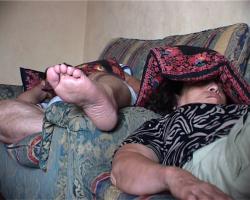
Ziad Antar
Safe sound
Experimental video | dv | color | 9:0 | Lebanon, France | 2006
Safe Sound by Ziad Antar, RT: 8 mins. Synopsis: As the siege took hold and the assault unrelented, the rountine of everyday life was suspended and time stood still. When one is not immediately exposed to danger, survival became about coping with the sense captivity, passing time.
Filmmaker?s Biography: Ziad Antar lives and works between Lebanon and France. He graduated with a degree in agricultural engineering in 2001, and has been working in photography and video since 2002. His videos include Safe Sound (2006), Marche Turque (2007) and Mdardara (2007). He directed his first documentary Jean-Luc Moulène in 2002.
Catalogue : 2007WA | Experimental video | dv | color | 2:30 | Lebanon, France | 2004
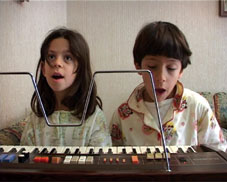
Ziad Antar
WA
Experimental video | dv | color | 2:30 | Lebanon, France | 2004
Two kids play on a synthesizer and create their own song.
Ziad Antar was born in Saida, Lebanon, in 1978. He currently lives in Paris and has been working in video and photography since 2002. He graduated as an agriculture engineer in 2001 in Beirut, and then completed a one year residency in Palais de Tokyo, Le Pavillon in 2003.
Pia Antikainen
Emmanuelle Antille, -
Catalogue : 2010Strings of Affection | Video | dv | color | 9:41 | Switzerland | 2009
Emmanuelle Antille
Strings of Affection
Video | dv | color | 9:41 | Switzerland | 2009
"Strings of Affection" shows the particular connection of a woman with her domestic space Using a ball of string, she begins weaving threads through all the rooms of the house, creating a web inside the apartment. Little by little a strange inner geometry takes shape, a geometry which is at once very liberating, but starts to be paradoxically totally constricting. The apartment becomes a mental space, a mirror place of the psyche of the character, " as if we could follow the thread of her thoughts ". The architecture appears as a place of mutation, at the same time very opened on the outside, while closing on itself as a trap. Taken in this net, the woman?s body is forced, whereas its spirit escapes and the gestures are liberated.
Emmanuelle Antille was born in 1972 in Lausanne, Switzerland. She studied at the Ecole Supérieure d`Art Visuel in Geneva, and at the Rijksakademie in Amsterdam. She makes films, photographs and installations, writes texts and scripts, is a singer and musician. These heterogeneous aspects of her artistic production give life to autonomous works or to interventions in which the fusion of these various elements animate installations where dream, illusion and reality merge and overlap. Her interest is concentrated on the analysis of domestic relations and behaviours, the dynamics established within groups, and behavioural that characterise the life of a clan. With actors in her films, she creates scenes in which human relations analysed within a ritual, such as a game, become exasperated into tortured confessions or mysterious silences. Her stories are a subtle and poetic reflection on questions relating to the double, to introspection, and to communication with others: ?All my work rotates around a certain distance from reality, the relationship with sound, the boundary between dream and reality, hallucination?. The language of video becomes a way to rewrite emotions, to capture life in its most intimate aspects, to translate dream images into reality. Antille has received several recognitions and awards including: three Swiss Art Awards, Kiefer-Hablitzel Prize, Review + film contest, Migros Culture, Swiss Studio in Berlin and in Couvent des Recollets in Paris. Her exhibitions include: Kunstverein in Frankfurt, The Renaissance Society in Chicago, CCA in Glasgow, Site Gallery in Sheffield, Toyko Wonder Site in Tokyo, De Appel in Amsterdam, Migros Museum in Zürich, Musée du Jeu de Paume in Paris. In 2003 she represented Switzerland in the 50th edition of the Venice Biennale.
Catalogue : 2009Barricata | Experimental fiction | dv | color | 19:52 | Switzerland | 2007
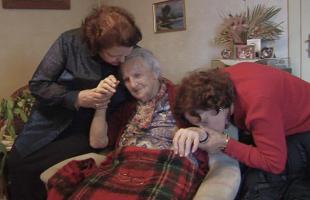
Emmanuelle Antille, -
Barricata
Experimental fiction | dv | color | 19:52 | Switzerland | 2007
Barricata est une vidéo en trois actes se jouant autour de quatre personnages féminins : la grand-mère, ses deux filles et sa petite fille. Axée sur le thème de l?abandon (de soi, des autres, de ses biens, de son corps ou de sa mémoire), cette vidéo présente les relations intimes entre les membres d?une même famille. Dans le premier acte, les quatre femmes, cloîtrées dans la cuisine, attendent et guettent l?arrivée de deux inconnus. Ceux-ci pénètrent dans la maison, l?inspectent, barricadent la pièce principale, puis repartent aussi soudainement qu?ils sont apparus. Dans le deuxième acte, les quatre femmes sortent de leur isolement et reprennent possession des lieux. Elles effectuent de petits rituels intimes et obsessionnels, ensemble ou séparément. Ces rituels leur permettent d?établir une tension avec leur environnement, de reprendre le contrôle ou de lâcher prise. Ainsi, ces femmes rejouent et réinventent les relations qui les unissent, jusqu?à l?hallucination parfois. Dans le troisième acte, les deux inconnus reviennent. Les femmes sont alors prêtes à les rencontrer, prêtes à leur livrer une part de leur histoire. Ils se retrouvent alors tous ensemble dans le salon barricadé.
Emmanuelle Antille Née à Lausanne en 1972. Vit et travaille à Lausanne. 1997-1998 Rijksakademie van Beeldende Kunsten, Amsterdam 1991-1996 Ecole Supérieure d`Art Visuel, Genève Expositions personnelles (sélection) : 2008 Family Viewing, Centre PasquArt, Bienne Editing Room / Editing Territories, Art Unlimited, Bâle 2007 Barricata, Salle Noire, Musée d?Art Moderne de la Ville de Paris/ARC, Paris Inner Streams, COMA, Berlin Skull Shaker, Galleria Roberto Giustini, Rome 2006 Le Journal de Jack, Galerie Eva Presenhuber, Zürich Angels Camp, Simon Fraser University Gallery, Vancouver. Kill me twice, dear friend, dear enemy, Nichido Contemporary Art, Tokyo Tornadoes of my Heart, Tokyo Wonder Site, Tokyo Cures & Comas, Marc Hostettler, Neuchâtel 2005 Kill me twice, dear friend, dear enemy, Art Unlimited, Bâle Centre pour l?image contemporaine Saint Gervais, Genève 2004 Angels and Landscapes, Galerie Akinci, Amsterdam Angels Camp ? First Songs, CCA, Glasgow Angels Camp ? Radiant Spirits, Sammlung Goetz, Münich Angels Camp ? First Songs, Site Gallery, Sheffield Night For Day, Centro Atlantico de Arte Modernao, Las Palmas Gran Canaria 2003 Angels Camp, The Renaissance Society, Chicago NB, Kunsthaus Baselland, Muttenz Angels Camp, Pavillon Suisse, 50ème Biennale de Venise, Venise Expositions collectives (sélection) : 2008 Shifting Identities, Kunsthaus Zürich Identity, Nichido Contemporary Art, Tokyo You Are My Mirror 1: L?Infamille, Frac Lorraine, Metz about: safety scaffold, :emyt, Berlin SUPERNATURAL, Kunsthalle Andratx, Mallorca Accrochage, Musée des Beaux-Arts, Lausanne La Durée, National Islandic Gallery, Reykjavik 2007 Global Feminisms, Brooklyn Art Museum, New York Dark Mirror, Montevideo Time Based Arts, Amsterdam Global Feminisms, Davis Art Museum / Wellesley, Wellesley Art en Plein Air Môtiers 2007, Môtiers Love Addiction, Galleria Comunale d?Arte Contemporanea di Monfalcone, Monfalcone Video Salon, Galerija 10 m2, Sarajevo Dadada, Hammam de Mostar, Sarajevo Videoskulptur 07, Baden Surréalités, Centre PasquArt Kunsthaus, Bienne Outre-Tombe, Galerie 1m3, Lausanne Monumenta, projection d?Angels Camp, Grand-Palais, Paris Résidents, Espace Electra, Paris Jubliee Exhibition, House Eva Presenhuber, Vnà Triennale de l?imprimé contemporain, Musée des Beaux-Arts, Le Locle 2006 Nouvelles Collections, Centre PasquArt, Bienne Frictions, Espace des arts plastiques, Saint-Dié-des-Vosges Visioni del Paradiso, Institut Suisse de Rome, Rome 1ère Biennale du Havre, Le Havre Eldorado, MUDAM, Luxembourg WoMA. Women Making Art, André Schlechtriem Temporary Inc., New York 2005 Fast Forward, Media Art, Goetz Collection, Conde Duque, Madrid Madonna ? Express yourself, Kunsthaus Dresden Swiss Made (The Art of Falling Apart), Cobra Museum, Amstelveen Refleksija, Nizhnij Novgorod, National Center for Contemporary Arts, Moscou The Parable Show, Grimm/Rosenfeld gallery, Münich Croiser des mondes, Musée du Jeu de Paume, Paris Goetz meets Flackenberg, Phoenix Art, Hamburg T 142, Gallery Deweer, Ottegem At The Launderette, Lausanne Desire, Para/Site Art Space, Hong Kong Frictions, Fonds régional d?art contemporain de Lorraine, Metz Alias & Alibi, Fries Museum, Leeuwarden Festivals vidéos (sélection) / Projections : 2008 PointLignePlan 10 ans, Centre Pompidou, Paris La Blanchisserie, Paris Rencontres Internationales Paris/Berlin/Madrid, Musée National Reina Sofia, Madrid 2007 KunstFilm Biennale, Köln/Bonn Rencontres Internationales Paris/Berlin/Madrid, Berlin 2006 Festival du Film de Trieste, Trieste Festival du Film de Locarno, Locarno Swiss Video, Tate Modern, Londres 2005 Compétition video, Festival du Film de Locarno Prix : 2005 Prix en Arts Visuels de la Fondation Vaudoise pour la Culture 2003 Résidence de la Mairie de Paris au Couvent des Récollets, Paris 2001 Prix Fédéral des Beaux-Arts Prix Kiefer-Hablitzel Atelier Suisse à Berlin 2000 Prix Fédéral des Beaux-Arts Prix Kiefer-Hablitzel 1999 ConcoursFédéral des Beaux-Arts Review + film contest, Migros Culture 1996 Fonds Cantonal de Décoration et d`Art Visuel de Genève
Catalogue : 2008Even if we fall | Fiction | dv | color | 9:21 | Switzerland | 2007
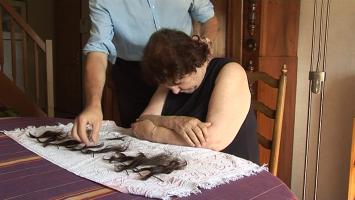
Emmanuelle Antille
Even if we fall
Fiction | dv | color | 9:21 | Switzerland | 2007
Even If We Fall is a video film of 9`30 questioning the relationships inside a family and the role played by each of its members. In a silent house, a father, mother and daughter are gathered together, waiting very still and quiet in the living room. Suddenly the mother grabs the daughter?s hands and the three of them leave the room to isolate themselves in the parents? bedroom. There they will perform a very unique ritual: the daughter having decided to offer her hair to her mother. The film presents the strong interactions between the daughter and her two parents in parallel with the very special bond that ties the father and the mother, re-questioning the notion of love and sacrifice inside the family cell.
Emmanuelle Antille was born in 1972 in Lausanne, Switzerland. She studied at the Ecole Supérieure d'Art Visuel in Geneva, and at the Rijksakademie in Amsterdam. She makes films, photographs and installations, writes texts and scripts, is a singer and musician. These heterogeneous aspects of her artistic production give life to autonomous works or to interventions in which the fusion of these various elements animate installations where dream, illusion and reality merge and overlap. Her interest is concentrated on the analysis of domestic relations and behaviours, the dynamics established within groups, and behavioural that characterise the life of a clan. With actors in her films, she creates scenes in which human relations analysed within a ritual, such as a game, become exasperated into tortured confessions or mysterious silences. Her stories are a subtle and poetic reflection on questions relating to the double, to introspection, and to communication with others: ?All my work rotates around a certain distance from reality, the relationship with sound, the boundary between dream and reality, hallucination?. The language of video becomes a way to rewrite emotions, to capture life in its most intimate aspects, to translate dream images into reality. Antille has received several recognitions and awards including: three Swiss Art Awards, Kiefer-Hablitzel Prize, Review + film contest, Migros Culture, Swiss Studio in Berlin and in Couvent des Recollets in Paris. Her exhibitions include: Kunstverein in Frankfurt, The Renaissance Society in Chicago, CCA in Glasgow, Site Gallery in Sheffield, Toyko Wonder Site in Tokyo, De Appel in Amsterdam, Migros Museum in Zürich, Musée du Jeu de Paume in Paris. In 2003 she represented Switzerland in the 50th edition of the Venice Biennale.
Catalogue : 2007A Place We Call Home | Experimental fiction | dv | color | 8:0 | Switzerland | 2006
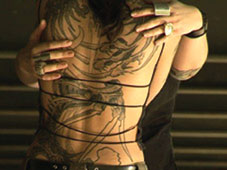
Emmanuelle Antille
A Place We Call Home
Experimental fiction | dv | color | 8:0 | Switzerland | 2006
"A Place We Call Home" leads us to the heart of strong and particular relations that link two women. The setting, both urban and savage, physically invaded by the vegetation, absorbs and reflects their rituals.
Emmanuelle Antille was born in 1972 in Lausanne where she lives and works. She studied at the Geneva Graduate School of Visual Arts from 1991 to 1996, then, from 1997 to 1998, at the Rijksacademie in Amsterdam. She uses a language that is sometimes minimal, sometimes emphatic. She auscultates the inside and the outside and she looks from the inside and the outside. This discipline of systematic analysis enables everyone to in turn examine one's self. Her works have been presented notably during video festivals like the ones in Zurich, New York, Le Caire, Vilnius, and Salamanque. In 2005, she presented "Rollow" at the Locarno festival and has been awarded the young creator prize of the Vaudois Foundation for the promotion of artistic creation.
Emmanuelle Antille
Catalogue : 2010Strings of Affection | Video | dv | color | 9:41 | Switzerland | 2009
Emmanuelle Antille
Strings of Affection
Video | dv | color | 9:41 | Switzerland | 2009
"Strings of Affection" shows the particular connection of a woman with her domestic space Using a ball of string, she begins weaving threads through all the rooms of the house, creating a web inside the apartment. Little by little a strange inner geometry takes shape, a geometry which is at once very liberating, but starts to be paradoxically totally constricting. The apartment becomes a mental space, a mirror place of the psyche of the character, " as if we could follow the thread of her thoughts ". The architecture appears as a place of mutation, at the same time very opened on the outside, while closing on itself as a trap. Taken in this net, the woman?s body is forced, whereas its spirit escapes and the gestures are liberated.
Emmanuelle Antille was born in 1972 in Lausanne, Switzerland. She studied at the Ecole Supérieure d`Art Visuel in Geneva, and at the Rijksakademie in Amsterdam. She makes films, photographs and installations, writes texts and scripts, is a singer and musician. These heterogeneous aspects of her artistic production give life to autonomous works or to interventions in which the fusion of these various elements animate installations where dream, illusion and reality merge and overlap. Her interest is concentrated on the analysis of domestic relations and behaviours, the dynamics established within groups, and behavioural that characterise the life of a clan. With actors in her films, she creates scenes in which human relations analysed within a ritual, such as a game, become exasperated into tortured confessions or mysterious silences. Her stories are a subtle and poetic reflection on questions relating to the double, to introspection, and to communication with others: ?All my work rotates around a certain distance from reality, the relationship with sound, the boundary between dream and reality, hallucination?. The language of video becomes a way to rewrite emotions, to capture life in its most intimate aspects, to translate dream images into reality. Antille has received several recognitions and awards including: three Swiss Art Awards, Kiefer-Hablitzel Prize, Review + film contest, Migros Culture, Swiss Studio in Berlin and in Couvent des Recollets in Paris. Her exhibitions include: Kunstverein in Frankfurt, The Renaissance Society in Chicago, CCA in Glasgow, Site Gallery in Sheffield, Toyko Wonder Site in Tokyo, De Appel in Amsterdam, Migros Museum in Zürich, Musée du Jeu de Paume in Paris. In 2003 she represented Switzerland in the 50th edition of the Venice Biennale.
Catalogue : 2009Barricata | Experimental fiction | dv | color | 19:52 | Switzerland | 2007

Emmanuelle Antille, -
Barricata
Experimental fiction | dv | color | 19:52 | Switzerland | 2007
Barricata est une vidéo en trois actes se jouant autour de quatre personnages féminins : la grand-mère, ses deux filles et sa petite fille. Axée sur le thème de l?abandon (de soi, des autres, de ses biens, de son corps ou de sa mémoire), cette vidéo présente les relations intimes entre les membres d?une même famille. Dans le premier acte, les quatre femmes, cloîtrées dans la cuisine, attendent et guettent l?arrivée de deux inconnus. Ceux-ci pénètrent dans la maison, l?inspectent, barricadent la pièce principale, puis repartent aussi soudainement qu?ils sont apparus. Dans le deuxième acte, les quatre femmes sortent de leur isolement et reprennent possession des lieux. Elles effectuent de petits rituels intimes et obsessionnels, ensemble ou séparément. Ces rituels leur permettent d?établir une tension avec leur environnement, de reprendre le contrôle ou de lâcher prise. Ainsi, ces femmes rejouent et réinventent les relations qui les unissent, jusqu?à l?hallucination parfois. Dans le troisième acte, les deux inconnus reviennent. Les femmes sont alors prêtes à les rencontrer, prêtes à leur livrer une part de leur histoire. Ils se retrouvent alors tous ensemble dans le salon barricadé.
Emmanuelle Antille Née à Lausanne en 1972. Vit et travaille à Lausanne. 1997-1998 Rijksakademie van Beeldende Kunsten, Amsterdam 1991-1996 Ecole Supérieure d`Art Visuel, Genève Expositions personnelles (sélection) : 2008 Family Viewing, Centre PasquArt, Bienne Editing Room / Editing Territories, Art Unlimited, Bâle 2007 Barricata, Salle Noire, Musée d?Art Moderne de la Ville de Paris/ARC, Paris Inner Streams, COMA, Berlin Skull Shaker, Galleria Roberto Giustini, Rome 2006 Le Journal de Jack, Galerie Eva Presenhuber, Zürich Angels Camp, Simon Fraser University Gallery, Vancouver. Kill me twice, dear friend, dear enemy, Nichido Contemporary Art, Tokyo Tornadoes of my Heart, Tokyo Wonder Site, Tokyo Cures & Comas, Marc Hostettler, Neuchâtel 2005 Kill me twice, dear friend, dear enemy, Art Unlimited, Bâle Centre pour l?image contemporaine Saint Gervais, Genève 2004 Angels and Landscapes, Galerie Akinci, Amsterdam Angels Camp ? First Songs, CCA, Glasgow Angels Camp ? Radiant Spirits, Sammlung Goetz, Münich Angels Camp ? First Songs, Site Gallery, Sheffield Night For Day, Centro Atlantico de Arte Modernao, Las Palmas Gran Canaria 2003 Angels Camp, The Renaissance Society, Chicago NB, Kunsthaus Baselland, Muttenz Angels Camp, Pavillon Suisse, 50ème Biennale de Venise, Venise Expositions collectives (sélection) : 2008 Shifting Identities, Kunsthaus Zürich Identity, Nichido Contemporary Art, Tokyo You Are My Mirror 1: L?Infamille, Frac Lorraine, Metz about: safety scaffold, :emyt, Berlin SUPERNATURAL, Kunsthalle Andratx, Mallorca Accrochage, Musée des Beaux-Arts, Lausanne La Durée, National Islandic Gallery, Reykjavik 2007 Global Feminisms, Brooklyn Art Museum, New York Dark Mirror, Montevideo Time Based Arts, Amsterdam Global Feminisms, Davis Art Museum / Wellesley, Wellesley Art en Plein Air Môtiers 2007, Môtiers Love Addiction, Galleria Comunale d?Arte Contemporanea di Monfalcone, Monfalcone Video Salon, Galerija 10 m2, Sarajevo Dadada, Hammam de Mostar, Sarajevo Videoskulptur 07, Baden Surréalités, Centre PasquArt Kunsthaus, Bienne Outre-Tombe, Galerie 1m3, Lausanne Monumenta, projection d?Angels Camp, Grand-Palais, Paris Résidents, Espace Electra, Paris Jubliee Exhibition, House Eva Presenhuber, Vnà Triennale de l?imprimé contemporain, Musée des Beaux-Arts, Le Locle 2006 Nouvelles Collections, Centre PasquArt, Bienne Frictions, Espace des arts plastiques, Saint-Dié-des-Vosges Visioni del Paradiso, Institut Suisse de Rome, Rome 1ère Biennale du Havre, Le Havre Eldorado, MUDAM, Luxembourg WoMA. Women Making Art, André Schlechtriem Temporary Inc., New York 2005 Fast Forward, Media Art, Goetz Collection, Conde Duque, Madrid Madonna ? Express yourself, Kunsthaus Dresden Swiss Made (The Art of Falling Apart), Cobra Museum, Amstelveen Refleksija, Nizhnij Novgorod, National Center for Contemporary Arts, Moscou The Parable Show, Grimm/Rosenfeld gallery, Münich Croiser des mondes, Musée du Jeu de Paume, Paris Goetz meets Flackenberg, Phoenix Art, Hamburg T 142, Gallery Deweer, Ottegem At The Launderette, Lausanne Desire, Para/Site Art Space, Hong Kong Frictions, Fonds régional d?art contemporain de Lorraine, Metz Alias & Alibi, Fries Museum, Leeuwarden Festivals vidéos (sélection) / Projections : 2008 PointLignePlan 10 ans, Centre Pompidou, Paris La Blanchisserie, Paris Rencontres Internationales Paris/Berlin/Madrid, Musée National Reina Sofia, Madrid 2007 KunstFilm Biennale, Köln/Bonn Rencontres Internationales Paris/Berlin/Madrid, Berlin 2006 Festival du Film de Trieste, Trieste Festival du Film de Locarno, Locarno Swiss Video, Tate Modern, Londres 2005 Compétition video, Festival du Film de Locarno Prix : 2005 Prix en Arts Visuels de la Fondation Vaudoise pour la Culture 2003 Résidence de la Mairie de Paris au Couvent des Récollets, Paris 2001 Prix Fédéral des Beaux-Arts Prix Kiefer-Hablitzel Atelier Suisse à Berlin 2000 Prix Fédéral des Beaux-Arts Prix Kiefer-Hablitzel 1999 ConcoursFédéral des Beaux-Arts Review + film contest, Migros Culture 1996 Fonds Cantonal de Décoration et d`Art Visuel de Genève
Catalogue : 2008Even if we fall | Fiction | dv | color | 9:21 | Switzerland | 2007

Emmanuelle Antille
Even if we fall
Fiction | dv | color | 9:21 | Switzerland | 2007
Even If We Fall is a video film of 9`30 questioning the relationships inside a family and the role played by each of its members. In a silent house, a father, mother and daughter are gathered together, waiting very still and quiet in the living room. Suddenly the mother grabs the daughter?s hands and the three of them leave the room to isolate themselves in the parents? bedroom. There they will perform a very unique ritual: the daughter having decided to offer her hair to her mother. The film presents the strong interactions between the daughter and her two parents in parallel with the very special bond that ties the father and the mother, re-questioning the notion of love and sacrifice inside the family cell.
Emmanuelle Antille was born in 1972 in Lausanne, Switzerland. She studied at the Ecole Supérieure d'Art Visuel in Geneva, and at the Rijksakademie in Amsterdam. She makes films, photographs and installations, writes texts and scripts, is a singer and musician. These heterogeneous aspects of her artistic production give life to autonomous works or to interventions in which the fusion of these various elements animate installations where dream, illusion and reality merge and overlap. Her interest is concentrated on the analysis of domestic relations and behaviours, the dynamics established within groups, and behavioural that characterise the life of a clan. With actors in her films, she creates scenes in which human relations analysed within a ritual, such as a game, become exasperated into tortured confessions or mysterious silences. Her stories are a subtle and poetic reflection on questions relating to the double, to introspection, and to communication with others: ?All my work rotates around a certain distance from reality, the relationship with sound, the boundary between dream and reality, hallucination?. The language of video becomes a way to rewrite emotions, to capture life in its most intimate aspects, to translate dream images into reality. Antille has received several recognitions and awards including: three Swiss Art Awards, Kiefer-Hablitzel Prize, Review + film contest, Migros Culture, Swiss Studio in Berlin and in Couvent des Recollets in Paris. Her exhibitions include: Kunstverein in Frankfurt, The Renaissance Society in Chicago, CCA in Glasgow, Site Gallery in Sheffield, Toyko Wonder Site in Tokyo, De Appel in Amsterdam, Migros Museum in Zürich, Musée du Jeu de Paume in Paris. In 2003 she represented Switzerland in the 50th edition of the Venice Biennale.
Catalogue : 2007A Place We Call Home | Experimental fiction | dv | color | 8:0 | Switzerland | 2006

Emmanuelle Antille
A Place We Call Home
Experimental fiction | dv | color | 8:0 | Switzerland | 2006
"A Place We Call Home" leads us to the heart of strong and particular relations that link two women. The setting, both urban and savage, physically invaded by the vegetation, absorbs and reflects their rituals.
Emmanuelle Antille was born in 1972 in Lausanne where she lives and works. She studied at the Geneva Graduate School of Visual Arts from 1991 to 1996, then, from 1997 to 1998, at the Rijksacademie in Amsterdam. She uses a language that is sometimes minimal, sometimes emphatic. She auscultates the inside and the outside and she looks from the inside and the outside. This discipline of systematic analysis enables everyone to in turn examine one's self. Her works have been presented notably during video festivals like the ones in Zurich, New York, Le Caire, Vilnius, and Salamanque. In 2005, she presented "Rollow" at the Locarno festival and has been awarded the young creator prize of the Vaudois Foundation for the promotion of artistic creation.
Ralph Antunes, Pedro Maia de Brito, Leonardo Amaral
Catalogue : 2025Tudo que vi era o sol | Experimental doc. | 4k | color | 20:56 | Brazil | 2023
Ralph Antunes, Pedro Maia de Brito, Leonardo Amaral
Tudo que vi era o sol
Experimental doc. | 4k | color | 20:56 | Brazil | 2023
Gil works in construction, goes to his mother’s bar and has love dates with Katia. On a day like so many others, Gil is disappearing.
Ralph Antunes is a director, editor and producer. Graduated in Digital Arts at the Fine Arts School of UFMG, he produced and co-directed the short films Carga Viva (2013), Boa Morte (2015), Praça do Peixe (2018) and Tudo Que Vi Era o Sol (2023), which were shown at important festivals such as Doclisboa, FIC Valdivia, Málaga, Brasília and Tiradentes. As an artistic assistant, since 2014 he has collaborated with filmmaker and artist Cao Guimarães, coordinating the workflow of the artist's audiovisual and photographic productions and communicating his studio with art institutions around the world. Together with Pedro Maia de Brito, he is currently developing his first feature film, The Scarlet Temple Oracle, winner of the prize for best project in development in the Arché - Doclisboa'23.
Josh Appignanesi, The film is by APPIGNANESI Josh, the song is by CREED Martin
Catalogue : 2013DIE | A film by Josh APPIGNANESI / A song by Martin CREED | Video | hdv | color | 3:0 | United Kingdom | 2012
Josh Appignanesi, The film is by APPIGNANESI Josh, the song is by CREED Martin
DIE | A film by Josh APPIGNANESI / A song by Martin CREED
Video | hdv | color | 3:0 | United Kingdom | 2012
DIE is a collaboration between Turner Prize winning artist Martin CREED who made the song "Die" and feature filmmaker Josh APPIGNANESI who created a response to the song. The film brings into play multiple notions of being exposed and yet remaining mysterious; rendered utterly naked under the spotlight with reference to torture imagery and Abu Ghraib, and yet withholding the mystery of the interior, with reference to papparazzi photos of celebrities holding up their hands. The result is strangely joyous. In terms of the ongoing collaboration between the artists, the piece crosses over between experimental film and music video and in so doing makes reference to Creed`s own previous video work in this vein, as well as to Appignanesi`s feature film work such as Song Of Songs (2005.)
Josh APPIGNANESI is a writer/director based in London. He directed the feature films The Infidel and Song Of Songs. Working across genres, he has also made short films, video art, music videos, documentaries, commercials and artworks, working with cast such as John Malkovich, Richard Schiff, David Tennant, Omid Djalili, and Tom Hiddleston. He teaches internationally. www.joshappignanesi.com Martin CREED is a renowned British artist and musician working internationally. He won the Turner Prize in 2001. www.martincreed.com
Gints Apsits
Salvatore Arancio
Catalogue : 2014Birds | Experimental film | super8 | color | 6:31 | Italy, United Kingdom | 2012
Salvatore Arancio
Birds
Experimental film | super8 | color | 6:31 | Italy, United Kingdom | 2012
The film shot on Super 8 was filmed at the Zoology museum in Bologna. The museum was founded in 1860 part of the University of Bologna and is the largest and most significant in Italy. Rows and rows of cabinets filled with strangely shaped animals. It traces its roots all the way back to the very first cabinet of curiosity and the collection of Ulisse Aldrovandi, who allegedly coined the word Geology and is undisputedly one of the fathers of natural history. The film follows Arancio?s fascination with the human? s preoccupation to bring order to the world around us and the aesthetics related to the systems of classification used for this purpose. With this work the artist presents us with a subjective vision of the ornithological collection created by Zafagnini-Bertocchi in the first half of the 20th Century. Through the juxtaposition of deep gravitational rumbling sounds by LA cosmic cult music project Expo 70 and Arancio? s precise editing, still close ups and slow camera panning, the film exposes the sinister and uncanny nature of the displays, resulting in an ambiguous temporality, a visionary experience that transcends and transforms the original scientific illustrative purpose of the cabinets.
Born in Catania, Italy in 1974. Lives and works in London. He received his MA in Photography from the Royal College of Art. His artistic signature is photo-etching, but he works across a range of media such as sculpture, collage, animation and video. Arancio?s main interest lies in the potential of images. Departing from their literal meaning, he creates new juxtapositions that are both beautifully evocative and deeply disquieting. He looks to nature and science for his sources of inspiration, while unsettling any hint of the sublime by re-framing the images and the viewer?s experience. His constructed landscapes contain a sense of both the familiar and the unknown that enhances their symbolic readings and implications. Selected exhibitions: PROJECT: Salvatore Arancio, Rachel Cattle & Steve Richards, James Pyman, Maureen Paley Gallery, London, UK, 2013; PROJECT 03: Data, Contemporary Art Society, London, UK, 2013 (group show); Le Ragioni della Pittura. Esisti e prospettive di un medium, Palazzo de Sanctis, Castelbasso (Teramo), Italy, 2013 (group show); Curiosity. Art & the Pleasure of Knowing (Hayward Touring), Turner Contemporary, Margate, UK, 2013, touring to Norwich Castle Museum & Art Gallery, Norwich, UK, Royal Hibernian Academy, Dublin, Ireland, de Appel, Amsterdam, The Netherlands (group show); Cyclorama, Museo Tamayo Arte Contemporáneo, Mexico DF, Mexico (group show), 2013; Alternating Layers of Contrasting Resistance, Rowing Gallery, London, UK; The Little Man of the Forest With the Big Hat, Federica Schiavo Gallery, Rome, Italy; Relatively Absolute, Wysing Arts Centre, Cambridge, UK; Solo Presentation, Art Rotterdam 2013-New Art Section, Rotterdam, The Netherlands; The Little Man of the Forest With the Big Hat, MCZ-Museo Carlo Zauli, Faenza, Italy, 2012; An Arrangement of the Materials Ejected, Spacex, Exeter, UK, 2011; To See an Object to See a Light, Fondazione Sandretto Re Rebaudengo, Guarene d?Alba, Italy, 2011; Shasta, Federica Schiavo Gallery, Roma, 2011; Sentinel - PPS//Meetings#4, Palazzo Riso - Museo d?Arte Contemporanea della Sicilia, Palermo, Italy, 2011; SI-Sindrome Italiana, Le Magasin - Centre National d?Art contemporain de Grenoble, France, 2010; An Account of the Composition of the Earth?s Crust: Dirt Cones and Lava Bombs, Frame, Frieze Art Fair, London, UK, 2010; Catastrophe? Quelle Catastrophe!, Manif d?Art 5, The Quebec City Biennial, Engramme, Quebec City, Canada, 2010; Prague Biennale 4, Karlin Hall, Prague, Czech Republic, 2009; I giovani che visitano le nostre rovine non vi vedono che uno stile, GAM-Galleria d?Arte Moderna, Turin, Italy, 2009. Arancio was selected fot the Résidences Internationales aux Recollets, Paris, France, 2013; Sundaymorning@ekwc, European Ceramic WorkCentre, SG ?s-Hertogenbosch, The Netherlands; Wysing Arts Center Artist Residency, Cambridge, UK and Artist Residency and Ceramic Workshop, Museo Carlo Zauli, Faenza in 2012. He won The Elephant Trust Grant, London and The Art Omi Residency, New York in 2011, the Premio ?New York? in 2009 and was selected for the Bloomberg New Contemporaries in 2006.
Catalogue : 2012Untitled (Pavilion) | Experimental film | 16mm | black and white | 2:56 | Italy, United Kingdom | 2009
Salvatore Arancio
Untitled (Pavilion)
Experimental film | 16mm | black and white | 2:56 | Italy, United Kingdom | 2009
The film focuses on the New York's State Pavilion, an iconic building and one of the few surviving structures of the New York World`s Fair, held in Flashing Meadows in 1964. In Arancio's timeless abstract film, the camera slowly panning from the ground to the top end of the building, presents us a subjective reading of its architectural elements. Shot on Super 8 in one take, the film aims to juxtapose the construction's original utopian visionary aesthetics with Arancio's interest in apocalyptic representation and fascination for transient beauty.
Salvatore Arancio was born in Catania, Italy in 1974. He lives and works in London. He studied Photography at the Royal College of Art. His most recent exhibitions include: An Arrangement of the Materials Ejected, Spacex, UK, 2011; To See an Object to See a Light, Fondazione Sandretto Re Rebaudengo, Guarene d?Alba, Italy, 2011; Shasta, Federica Schiavo Gallery, Rome; ?Sentinel - PPS//Meetings#4?, Palazzo Riso - Museo d`Arte Contemporanea della Sicilia, Palermo, 2011; ?SI-Sindrome Italiana?, Le Magasin - Centre National d?Art contemporain de Grenoble, France, 2010; ?Catastrophe? Quelle Catastrophe!? Manif d?Art 5, The Quebec City Biennial, Engramme, Quebec City, Canada, 2010; ?An Account of the Composition of the Earth?s Crust: Dirt Cones and Lava Bombs?, Frame, Frieze Art Fair, London, UK, 2010; Prague Biennale 4, Karlin Hall, Prague, Czech Republic, 2009; ?I giovani che visitano le nostre rovine non vi vedono che uno stile?, GAM-Galleria d?Arte Moderna, Turin, 2009. Arancio was the recipient of the Art Omi Residency (New York) and a grant from The Elephant Trust (London) in 2011, and of the ?New York? Prize in 2009. He was selected for the Bloomberg New Contemporaries in 2006.
Mauricio Arango
Catalogue : 2021Seafarer | Experimental film | mov | color | 26:0 | Colombia, USA | 2020
Mauricio Arango
Seafarer
Experimental film | mov | color | 26:0 | Colombia, USA | 2020
Seafarer is an experimental narrative film. It combines an essayistic style with field recordings, fragments of visual studies, experiments with actors, and fictionalized reflection on artistic production rooted in personal experience. It presents a single monologue over mostly long-take shots depicting quotidian moments shot across New York City: a sunset over the Hudson River; people at the beach; a film projected in a movie theater; golfers at a course in Chelsea Piers, and so on. The visual montage is linked by a ruminative, first-person voiceover by Miami-based singer, Little Annie, who performs the character of an anonymous film director. Her haunting words, spoken with humor and earnestness, offer a meditation on the cracks in her life as an artist. They touch on a variety of topics, including our ambiguous relation with capital, the complex relationship between actors and directors, the experience of being in a cinema, and the periods when new ideas are scarce. Seafarer keenly elicits tensions between observer and creator, and what is scripted and what is captured by chance.
Mauricio Arango was born in Bogotá, Colombia and lives and works in New York City. He is an alumnus of the Independent Study Program at the Whitney Museum and has participated in residences at Headlands Art Center in San Francisco, the MacDowell Artist Colony, USA; Museo El Barrio, New York. He earned and MFA from the University of Minnesota. His films have been screened at art and film festivals including New Directors/New Films at the Lincoln Film Society and The Museum of Modern Art, New York; Kino Der Kunst, Münich; VideoBrasil, Sao Paulo; FiD Marseille, Rencontres Internationales, Paris; IndieLisboa, Lisbon. He has received awards in the form of financial support from institutions including The Foundation For Contemporary Art, New York; RivieraLab Coproduction Fund, Mexico; Secretary of Culture, Colombia; Filmmakers Fund, Rooftop Films, New York; Matt Robert Arts, London; Bush Foundation For the Arts, Saint Paul, USA; The Jerome Foundation, New York; the National Fund for the Arts from the National Association of Latino Artists and Communities, USA; and The Minnesota State Arts Board, among others.
Catalogue : 2014EVERYTHING NEAR BECOMES FAR | Fiction | hdcam | | 11:0 | Colombia | 2012
Mauricio Arango
EVERYTHING NEAR BECOMES FAR
Fiction | hdcam | | 11:0 | Colombia | 2012
Everything Near Becomes Far follows a day in the life of a couple living in a cabin nestled deep within the Andes mountain range in Colombia. They begin their day as usual, but something seems strange to the woman. A fearsome group of men awaits them. An atmosphere of dread develops gradually through the sounds and silences, a looming landscape and the threatening visions of wild animals observing the main characters from the distance. The film`s title is inspired by an observation the poet Borgues made on Goethe: ?Alles Nähe werde fern, everything near becomes far. Goethe was referring to the evening twilight. Everything near becomes far. It is true. At nightfall, the closest to us seems to move away from our eyes. So the visible world has moved away from my eye, perhaps forever. Goethe could be referring not only to twilight but to life. All things go off, leaving us. Old age is probably the supreme solitude -except that the supreme solitude is death?.?
Mauricio Arango was born in Colombia and lives and works in New York. He is an alumnus of the Independent Study Program at the Whitney Museum (New York, 2007), was a resident at the International Academy of Fine Arts in Salzburg (2005), Austria and earned an MFA from the University of Minnesota (2003). He is a fellow at the MacDowell Artist Colony, USA. His films and works have been shown in multiple festivals and screened in more than twenty countries including New Directors/New Films at the Lincoln Film Society and The Museum of Modern Art in New York, Kino Der Kunst in Münich, VideoBrasil in Sao Paulo, IndieLisboa in Portugal. He has received support from the Foundation for Contemporary Art, New York; Rooftop Films, New York; and The Bush Foundation for the Arts, USA, among others.
Vasco Araujo
Catalogue : 2009Augusta | Art vidéo | dv | color | 8:55 | Portugal | 2008
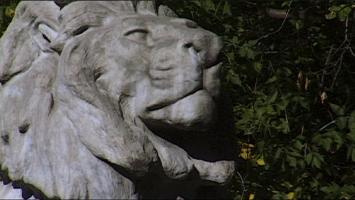
Vasco Araujo
Augusta
Art vidéo | dv | color | 8:55 | Portugal | 2008
Augusta, 2008 Video Duration: 7?23?? Text: Based on Aristofanes comedy ?The Birds?. Voices: Peter Shaw; Walter Bilderback Variable dimensions The video is reflection of the power abuses and political ideologies in the world through a conversation of two stone lions about a new place to live.
BIOGRAPHY Vasco Araújo was born in 1975 in Lisbon, the city where he continues to live and work. He completed his first degree in Sculpture in 1999 at FBAUL (Lisbon University School of Fine Art), and attended the Advanced Course in Visual Arts at Maumaus in Lisbon, from 1999 to 2000. Since then, he has participated in various solo and group exhibitions both in Portugal and abroad, also taking part in residency programmes, such as The University of Arts, Philadelphia (2007); Récollets, Paris (2005); and the Core Program (2003/04), Houston. In 2003, he was awarded the EDP Prize for New Artists. Amongst his solo exhibitions have been Eco (2008), Jeu de Paume, Paris; About being Different (2007), BALTIC Centre for Contemporary Art, U.K.; Pathos (2006), Domus Artium 2002, Salamanca; Dilemma (2005), S.M.A.K., Ghent; L?inceste (2005), Museu do Azulejo, Lisbon; The Girl of the Golden West (2005), The Suburban, Chicago; Dilema (2004), Museu de Serralves, Porto; Sabine/Brunilde (2003), SNBA, Lisbon. Amongst his group exhibitions, the most important have been his participation in the "Em vivo contacto", 28º Bienal de S. Paulo, Brazil; ?Experience of Art?, La Biennale di Venezia. 51st International Exhibition of Art, Venice; ?Dialectics of Hope?, 1st Moscow Biennial of Contemporary Art, Moscow, (both in 2005); Solo (For Two Voices), CCS, Bard College (2002), New York; ?The World Maybe Fantastic? Sydney Biennial (2002), Sydney; Trans Sexual Express, Barcelona (2001), a Classic for the Third Millennium (2001), Centre d?Art Santa Mònica, Barcelona. His work has been published in various books and catalogues and is represented in several public and private collections, such as at the Centre Pompidou, Musée d?Art Moderne (France); Fundação Calouste Gulbenkian (Portugal); Fundación Centro Ordóñez-Falcón de Fotografía ? COFF (Spain); Museo Nacional Reina Sofia, Centro de Arte (Spain); Fundação de Serralves (Portugal); Museum of Fine Arts, Houston (USA).
Catalogue : 2008Hereditas | Experimental video | dv | color | 12:0 | Portugal | 2006
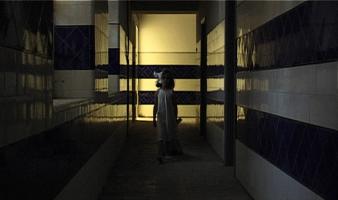
Vasco Araujo
Hereditas
Experimental video | dv | color | 12:0 | Portugal | 2006
Hereditas, this piece confronts us with a paradox. The action is intriguing, and the location suggests something strange, yet magical. A child comes out of the forest?s depths and, with guileless steps, leads us into a dilapidated sanatorium?s long, empty corridors, in a timeless, lonely, sometimes spectral itinerary. The paradox lies in the simple, straightforward way the mountain?s findings are handled. It represents an encounter with something essential, thought hidden, and which may reveal itself with a surprising cruelty, harsher than death itself. Hereditas it is a work on childhood, loneliness, pain, love, death and the desire for knowing and understanding the great enigmas and interrogations of our human, all too human condition.
Vasco Araújo was born in 1975 in Lisbon, the city where he continues to live and work. He completed his first degree in Sculpture in 1999 at FBAUL (Lisbon University School of Fine Art), and attended the Advanced Course in Visual Arts at Maumaus in Lisbon, from 1999 to 2000. Since then, he has participated in various solo and group exhibitions both in Portugal and abroad, also taking part in residency programmes, such as The University of Arts, Philadelphia (2007); Récollets, Paris (2005); and the Core Program (2003/04), Houston. In 2003, he was awarded the EDP Prize for New Artists. Selection of his solo exhibitions: About being Different (2007), BALTIC Centre for Contemporary Art, U.K.; Pathos (2006), Domus Artium 2002, Salamanca; Dilemma (2005), S.M.A.K., Ghent; L?inceste (2005), Museu do Azulejo, Lisbon; The Girl of the Golden West (2005), The Suburban, Chicago; Dilema (2004), Museu de Serralves, Porto; Sabine/Brunilde (2003), SNBA, Lisbon. Amongst his group exhibitions, the most important have been his participation in the ?Experience of Art?, La Biennale di Venezia. 51st International Exhibition of Art, Venice; ?Dialectics of Hope?, 1st Moscow Biennial of Contemporary Art, Moscow, (both in 2005); Solo (For Two Voices), CCS, Bard College (2002), New York; ?The World Maybe Fantastic? Sydney Biennial (2002), Sydney; Trans Sexual Express, Barcelona (2001), a Classic for the Third Millennium (2001), Centre d?Art Santa Mònica, Barcelona. His work has been published in various books and catalogues and is represented in several public and private collections, such as at the Centre Pompidou, Musée d?Art Moderne (France); Fundação Calouste Gulbenkian (Portugal); Fundación Centro Ordóñez-Falcón de Fotografía ? COFF (Spain); Museo Nacional Reina Sofia, Centro de Arte (Spain); Fundação de Serralves (Portugal); Museum of Fine Arts, Houston (USA).
Cory Arcangel